3.9.1. Rules for drawing vegetation items
When drawing vegetation items, you must adhere to the following rules.
Vegetation items:
- 3.9.1.1
-
Drawn in accordance with 2.7.1. General rules for drawing polygonal items.
- 3.9.1.2
-
Draw them regardless of their size (to the extent that the satellite image allows).
The external polygon of vegetation items is drawn based on the actual vegetation boundaries.
- 3.9.1.3
-
You can draw individual trees located at some distance from the greater woodlands area or other trees if they are visible on the satellite image.
Don't draw individual trees within the vegetation polygon (such as a woodland area or garden).
If a tree is a local attraction with cultural or historical significance, draw it as a placemark of the “Locations” category and the “Culture and attractions — Attraction” type (see section 3.6.2.1.1. Item type).
- 3.9.1.4
-
Draw vegetation items of the “Park, square”, “Block vegetation”, “Nature reserve” and “Cemetery” types along the borders of their territories (fences, cemetery perimeter in the absence of a fence, administrative borders of protected areas) or vegetation borders (for example, where the vegetation meets a road). Internal polygons for these types of items are drawn only when a part of their territory constitutes a different item with a different purpose.
You don't need to pay special attention to rounding corners when drawing vegetation items.
Rounded:
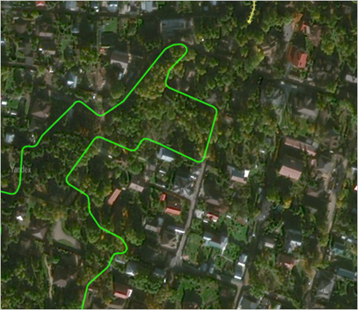
Not rounded:
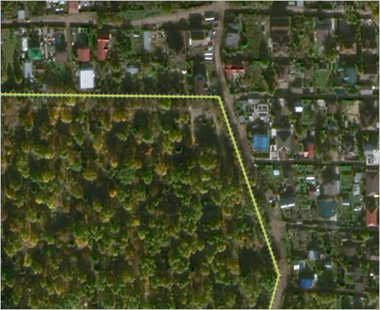
- 3.9.1.5
-
Outside of continually developed areas, you may draw railways and single-lane roads as intersecting vegetation.
Within continually developed areas, you may draw single-lane roads as intersecting vegetation if they go through this vegetation and belong to one of the following classes:
8 (Driveways).
7 (Roads of minimal significance) accessible only to pedestrians and/or bicyclists.
Both outside and within continually developed areas, vegetation of the “Park, square”, “Nature reserve” and “Cemetery” types may intersect with single-lane motorways of any type if these roads are exit ramps to these areas of vegetation or passages through said areas.
For example:
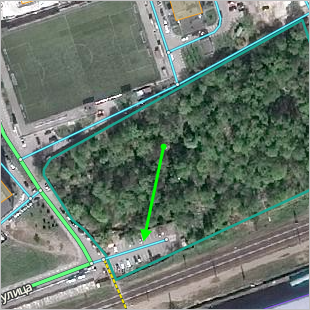
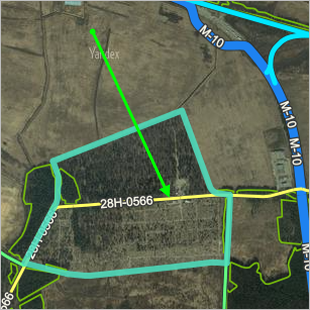


Roads and vegetation items located at different levels can intersect.
See also 3.3.1.1.8.
- 3.9.1.6
-
Lawns should be enclosed (by edging, curbs, fences, etc.). Draw the item outline based on the physical border of the section containing vegetation. For example:
Correct Incorrect 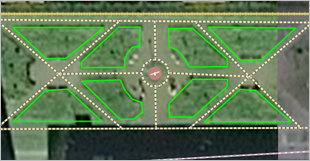
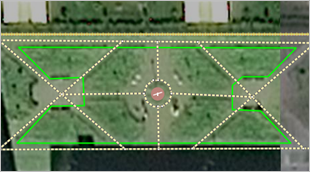
Correct Incorrect 

Draw sections with permanent grass cover. Avoid drawing sections that don't have grass cover.
Fields, meadows, and empty lots are not classified under this type: don't draw these items on YME.
For residential areas with single-family homes, lawns don't include grass vegetation that grows inside private neighborhoods and on private property:
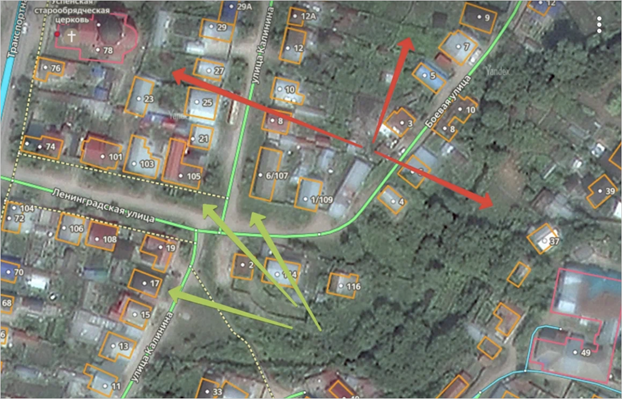
The green arrows indicate vegetation that can be drawn as “Lawn” items, while the red arrows point to vegetation that doesn't meet the criteria.
- 3.9.1.7
-
For “Urban vegetation” items, polygons should include trees and shrubs, as well as grass vegetation that meets the criteria for drawing lawns.
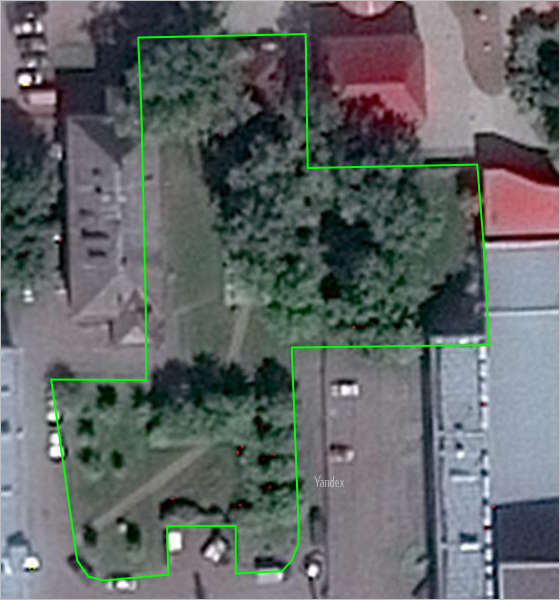
In those cases, you can also map vegetation in detail: draw the grass cover as a “Lawn” item and shrubs and trees as “Urban vegetation” items:
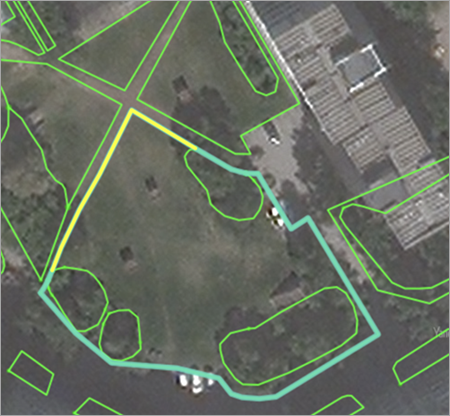 Note. When you're using this method, draw shrubs and trees in parks using the “Woodland” type instead of “Urban vegetation”.
Note. When you're using this method, draw shrubs and trees in parks using the “Woodland” type instead of “Urban vegetation”.Do not simplify urban vegetation polygons.
- 3.9.1.8
-
Roads drawn using two lines can not cut through a vegetation item: draw these items along both sides of such roads (i.e. the road divides the vegetation).
Borders of woodlands that are located along such roads should be drawn based on the actual vegetation borders (not based on the tree canopies) and should not intersect with the road.
- 3.9.1.9
- Fields, meadows, and other vegetation items that are not related to regular item types (Woodlands, Park, Square garden, Nature reserve, Lawn, Garden, Cemetery, see Section 3.9.2. Rules for adding attributes to vegetation items), for example, steppe or tundra landscapes (such as areas of mountain tundra, Arctic tundra), are drawn only if they belong to a “Nature reserve” (constitute a part of a protected area). Otherwise, don't draw such vegetation.
- 3.9.1.10
- Vegetation items that partly relate to the types of items used on YME (such as combined forest-tundra greenery) should be drawn in the area that relates to one of the categorized types. To take the previous example, you should draw the woodlands part of a forest-tundra vegetation area (including sparsely forested areas).
- 3.9.1.11
- When drawing internal polygons, follow 2.7.2. Rules for using internal polygons.
- 3.9.1.12
-
When drawing the sections of polygonal hydrographic items that border vegetation items, follow these rules:
- 3.9.1.12.1
-
If the item's polygon is completely contained by the polygon of a different category of item (such as if a lake or pond is located within a forest), then only draw the polygon for the item located within the other item (in this case, the lake or pond) along their border. Don't draw internal polygons for map items containing other items (for example, for a forest with a lake in it). Take this same approach when drawing river polygons that intersect woodlands or other items:
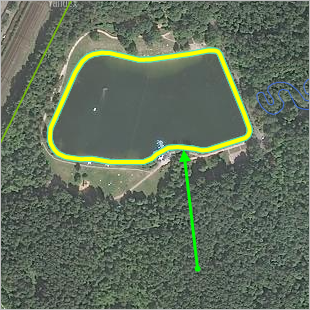
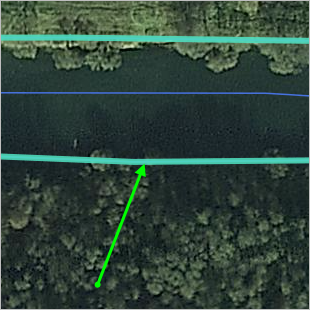


- 3.9.1.12.2
-
If the item polygon partially overlaps with the polygon of an item from a different category (for example, if woodlands encroach on part of the course of a river), then draw the borders of both items and try to make sure that there are no gaps between the borders.
Border of body of water Woodlands border 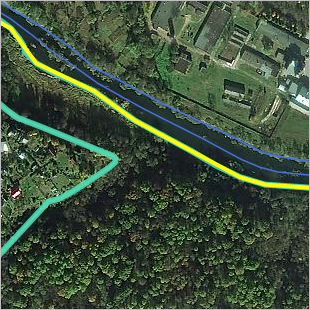
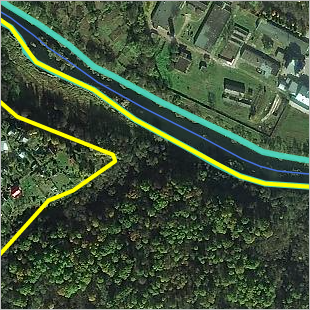
Border of body of water Woodlands border 

On the resulting map, the map item borders will be merged:
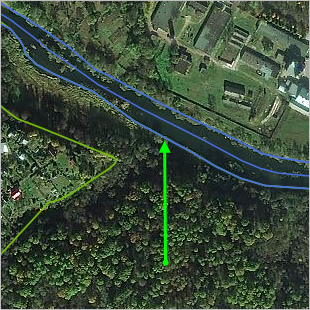 Note.
Note.For information on drawing overlapping border sections of composite polygonal items, see Section 2.7.4.1. Composite polygonal items: drawing techniques.
- 3.9.1.13
-
The polygons of different vegetation items shouldn't intersect. However, they can have shared borders.
“Woodlands” and “lawn” type vegetation items can exist inside “park, square”, nature reserve, and “cemetery” item polygons (those items are defined based on their use, similarly to “Territory” items).
Note. You can draw a “park, square” type item inside a larger “park, square” type item provided it doesn't violate other vegetation item drawing rules.If a “lawn” item is drawn inside a “park, square”, “nature reserve”, or “cemetery” item polygon, you can draw a “woodland” vegetation item inside it.
If a lawn item is drawn inside a park, square, nature reserve, or cemetery item polygon, you can draw an urban vegetation item inside it.
Note.For a detailed display of an item from the “Park, square” category, draw its vegetation in detail (when mapping lawns, include shrubs and trees).
- 3.9.1.14
-
It's preferable that vegetation items don't overlap with buildings.
If a vegetation item fully surrounds a building, then adding an inner polygon of vegetation for this building is considered a more accurate drawing. However, the vegetation may also overlap the building.
- 3.9.1.15
-
You should not add new external polygons to un-named vegetation items: drawing such polygons usually leads to mapping errors.